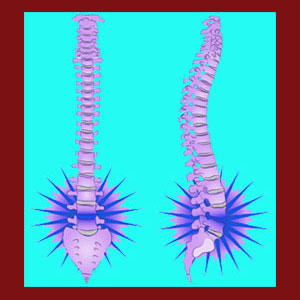
A hypermobile facet joint demonstrates an excessive range of motion that might create pain and instability. One of the primary jobs of the facet joints is to regulate the movement of each vertebral segment in relation to those which surround it. The facet joints are instrumental in regulating extension, flexion, lateral movement and rotation of the spinal vertebrae, with different ranges of motion being offered to each spinal level in relation to its intended function.
When a facet joint moves excessively, the range of motion is abnormally increased. This can compromise the stability of the vertebral level, the region of the spine or the entire backbone, depending on many factors. Additionally, abnormally excessive motion in a spinal segment might result in pain, although this is certainly not an inherent characteristic of all hypermobility conditions.
This discussion provides a crucial overview of facet joint hypermobility. We will discuss what factors cause hypermobile spinal joints, the symptoms that might be produced ad the therapies that are best for treating the condition.
Hypermobile Facet Joint Causes
Hypermobility is a more common consequence of aging than hypomobility. Generally, as we get older the facet joints become looser and less capable of preserving the complete integrity of the spinal column. The same processes that may incite hypomobility can also create hypermobility conditions. Osteoarthritis can cause hypertrophy and excessive movement the spinal joint in just as many cases as it can enact hypomobility.
Compression fractures can make the facet joints misalign and are a common clinical finding in the elderly. Likewise, degenerative spondylolisthesis, scoliosis, kyphosis and lordosis are all usual consequences of advanced age and can either cause facet joint hypermobility or be a result of existing facet hypermobility.
Spinal surgery and injury are 2 primary causes of facet hypermobility. Trauma to the facet joints might cause them to move abnormally due to dislocation or fracture.
Congenital conditions are often responsible for facet hypermobility from birth. Some people are simply born with excessive movement in some or all of their spinal joints as a result of some congenital abnormality.
Hypermobile Spinal Joint Consequences
As noted above, the facet joints are needed to regulate safe range of motion for each spinal segment. In people with congenital joint hypermobility, most abnormal movement is fully tolerated by the anatomy and does not result in any negative effects. However, when trauma, surgery, degeneration or other process cause the facet joints to lose the regulating ability over movement, then the following consequences may result:
Pain is an uncommon consequence of unstable facet joints, but might result due to mechanism or neurological mechanisms of action in select patient profiles.
Excessive movement can cause instability in a specific spinal segment, a regional area of the spine or the entire backbone. The greater the deficiencies in regulating proper and safe spinal movement, the worse the consequences of this instability will typically be. Serious consequences may include central and foraminal spinal stenosis, spinal cord injury, development of significant atypical curvatures or development of significant spondylolisthesis.
Hypermobility can result in fracture of the spinal processes, pars interarticularis or even the pedicle location from sudden, excessive spinal segment movement.
Treatment for a Hypermobile Facet Joint
Hypermobility is often left untreated, since many cases are not symptomatic and do not compromise spinal form or function to any notable degree. For cases that are symptomatic and/or problematic, treatment might be offered following any of the following care protocols:
Conservative treatment is often used to build the strength of the surrounding spinal musculature and help stabilize hypermobile segments. The use of exercises, stretches, physical therapy and ergonomic counseling can be very useful in helping to re-regulate spinal movement in minimally compromised regions.
Symptomatic care for pain might include chiropractic adjustments, massage, heat, ice, pharmaceutical intervention, injection therapy, TENS or other noninvasive modalities.
Surgical intervention is most often reserved for serious cases of symptomatic hypermobility. Surgical fixes will utilize spinal fusion to bond the hypermobile vertebral segment to its neighbor over 2 or more levels. In very rare instances, dislocations and other mechanical issues can be corrected without the need for spondylodesis techniques being utilized.
Facet Joint Pain > Causes of Facet Joint Pain > Hypermobile Facet Joint





